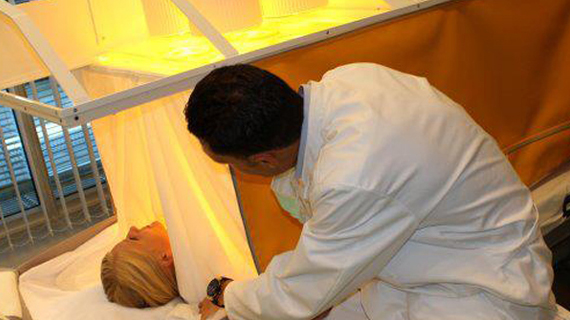Whole Body Hyperthermia
Whole Body Hyperthermia
Whole Body Hyperthermia (WBH) is the intentional warming of the whole body for therapeutic purposes. In recent years, interest in it has been renewed, as there have been technological advances that have made it safer, and medical advances that have made it necessary to supplement certain anti-cancer therapies. Total Hyperthermia is currently being used by a growing number of university hospitals in Europe and the United States to treat cancer and other diseases, such as AIDS, Lyme, and autoimmune diseases. Applied with the appropriate indications, it is now a very valuable part of integrated and personalized oncology.
Numerous scientific studies have shown that Whole Body Hyperthermia can cause:
- Maturation of dendritic cells (3).
- Presentation of cancer antigens in CD8 T-lymphocytes by dendritic cells (4).
- Prolonged activation of T-lymphocytes (5).
- Activation of monocytes and macrophages (6).
- Release of tumor necrosis a-factor (TNFa) (6).
- Multiplication of T-lymphocytes and naturally occurring Lymphocytes (Natural Killer Cells) (4,7,8).
- Stimulation of the immune system as a whole, as is done with natural fever (4).
Whole Body Hyperthermia is now more widely accepted as an effective, non-toxic therapeutic medical practice that complements immunotherapy, chemotherapy and radiotherapy, increasing their effectiveness.
Brief historical review
Therapeutic use of heat dates back to Ancient times. Ancient Greek physicians, especially Parmenides and Hippocrates, recognized the healing nature and clinical value of fever. In the 19th century, Busch and later other German physicians were the first to report the recurrence or cure of sarcomas in patients who, incidentally, fell ill with prolonged febrile infectious diseases. Dr. William Coley of New York achieved repetitive results in the treatment of cancer patients by using a mixture of bacterial endotoxins, which has since been known as Coley's Mixed Bacterial Vaccine. He even tried to make stable fever-inducing supplements (1).
Whole Body Hyperthermia Today
Today, the heating of the body from an external source has prevailed and is used, which are infrared lamps, filtered by a layer of water. This provides the advantage that the surface of the skin does not retain radiation, which thus penetrates the inside of the body with ease.
The purpose of full-body hyperthermia is to reproduce the beneficial effects of fever (2). When body temperatures are used at the level of 40-41o C for 1-2 hours, full body hyperthermia is characterized as extreme, while at the level of 39-40o C for 4-8 hours it is characterized as moderate hyperthermia. Mild hyperthermia has no effect on cancer. The main indication for the application of whole body hyperthermia is polymetastatic and generalized cancer, always in combination with chemotherapy or immunotherapy and other adjuvant therapies. The logic of the method is that cancer cells are more heat-sensitive than normal, that heating to fever levels stimulates all aspects of the immune system, and that high temperature facilitates the action of other treatments, especially chemotherapy and immunotherapy.
The reasons why cancer is heat-sensitive are that it is irrigated by abnormal neo-vessels (with abnormal properties), that within the nucleus of the tumors there is normally anaerobic metabolism and metabolic acidosis which tend to reverse with heating, and although the metabolism of tumors is accelerated by heating, the supply of nutrients does not increase accordingly (because neoplasms do not behave normally).

The technical side of full body hyperthermia is as follows:
The patient is placed in a special bed and connected to the monitoring instruments (thermometer, cardiograph, sphygmomanometer, hemoglobin saturation detector, etc.). A venous line is placed for chemotherapy and, in case of extreme hyperthermia, anesthesia, at the level of intoxication. It is then heated by 4 special infrared transmitters and covered so as not to dissipate heat. The temperature is monitored and maintained at the desired level for the appropriate time. Then begins the phase, of gradually return to normal temperature. At the end of the procedure, the patient feels very well due to the endorphins being released, and can leave if his general condition allows it. Before or during treatment, chemotherapy, high doses of vitamin C, selenium, antioxidants, etc. may be given. In case of immunotherapy with dendritic cells, these are given before the session. Whole body hyperthermia can also be combined with blood ozonation.
Bibliography
1.Nauts HC. Bacterial pyrogens: beneficial effects on cancer patients. In: Gautherie M, Albert E, editors. Biomedical Thermology, Progress in Clinical Biological Research. New York:Alan R. Liss; 1982. p 687-696.
2.Issels RD, Wilmanns W, editors. Recent Results in Cancer Research, Vol. 107: Application of Hyperthermia in the Treatment of Cancer.Berlin/Heidelberg: Springer Verlag; 1988.
3.Ostberg JR, Repasky EA. Emerging evidence indicates that physiologically relevant thermal stress regulates dendritic cell function. Cancer Immunol Immunother [Epub ahead of print]; Apr 28, 2005.
4.Manjili MH, et al. Subjeck, Cancer immunotherapy: stress proteins and hyperthermia. Int J Hyperthermia 2002;18(6): 506-520.
5.Atanackovic D, et al. 41.8 degrees C whole body hyperthermia as an adjunct to chemotherapy induces prolonged T cell activation in patients with various malignant diseases. Cancer Immunol Immunother Epub 2002 Oct 18 2002;51(11-12):603.
6.Barni S, et al. Lysosomal exocytosis induced by hyperthermia:
a new model of cancer death. III. effect on liver metastasis. Biomed Pharmacother 1996;50:79-84.
7.Burd R, et al. Tumor cell apoptosis, lymphocyte recruitment and tumor vascular changes are induced by low temperature, long duration (fever-like) whole body hyperthermia. J Cell Physiol 1998;177(1):137-147.
8.Shen RN, et al. Whole-body hyperthermia decreases lung metastases in lung tumor-bearing mice, possibly via a mechanism involving natural killer cells. J Clin Immunol.
Why in Personalized Oncology?
With personalization in oncology we are able to revive the patient's hope.
While we do not despise the therapeutic means of conventional oncology, on the contrary, we enrich the treatment....
More

